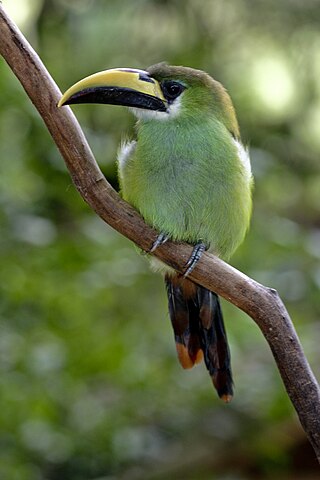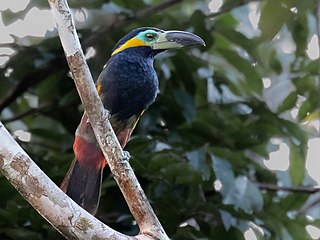
The emerald toucanet is a species of near-passerine bird in the toucan family Ramphastidae. It is found from Mexico to Nicaragua.

The blue-throated toucanet is a near-passerine bird in the toucan family Ramphastidae. It is found in Costa Rica, Panama and far northwestern Colombia.

The white-throated toucan is a near-passerine bird in the family Ramphastidae found in South America throughout the Amazon Basin including the adjacent Tocantins and Araguaia River drainage. It prefers tropical humid forest, but also occurs in woodland and locally in riverine forest within cerrado.

An aracari or araçari is any of the medium-sized toucans that, together with the saffron toucanet, make up the genus Pteroglossus.

The yellow-throated toucan is a Near Threatened species of bird in the family Ramphastidae, the toucans, toucanets, and aracaris. It is found from Honduras south into northern South America and beyond to Peru.

The western emerald is a species of hummingbird in the "emeralds", tribe Trochilini of subfamily Trochilinae. It is found in Colombia and Ecuador.

The Pirre hummingbird, also somewhat misleadingly known as the rufous-cheeked hummingbird, is a Near Threatened species of hummingbird in the "emeralds", tribe Trochilini of subfamily Trochilinae. It is found in Panama and far northwestern Colombia.

The scarlet-fronted parakeet, known in aviculture as the scarlet-fronted conure,red-fronted conure, or Wagler's conure, is a Near Threatened species of bird in subfamily Arinae of the family Psittacidae, the African and New World parrots. It is found in Colombia and Venezuela.

The rusty-vented canastero, or creamy-breasted canastero, is a species of bird in the Furnariinae subfamily of the ovenbird family Furnariidae. It is found in Argentina and Bolivia.

Green toucanets are near-passerine birds from the genus Aulacorhynchus in the toucan family. They are native to Mexico, and Central and South America. All are found in humid forests and woodlands in highlands, but a few also occur in adjacent lowlands. They are relatively small toucans, 30–44 centimetres (12–17 in) long, with colorful, mainly green, plumage. They are typically seen in pairs or small groups, and sometimes follow mixed species flocks.

The chestnut-tipped toucanet is a near-passerine bird in the toucan family Ramphastidae. It is found in Bolivia, Colombia, Ecuador, and Peru.

The groove-billed toucanet is a near-passerine bird in the toucan family Ramphastidae. It is found in Colombia and Venezuela.

The lettered aracari or lettered araçari is a near-passerine bird in the toucan family Ramphastidae. It is found in Bolivia, Brazil, Colombia, Ecuador, and Peru.

The brown-mandibled aracari is a near-passerine bird in the toucan family Ramphastidae. It is found in Bolivia, Brazil, and Peru.

The golden-collared toucanet is a near-passerine bird in the toucan family Ramphastidae. It is found in Bolivia, Brazil, Colombia, Ecuador, and Peru.

The yellow-eared toucanet is a near-passerine bird in the toucan family Ramphastidae. It is found from Honduras to Ecuador.

The tepui toucanet or Whitely's toucanet is a near-passerine bird in the toucan family Ramphastidae. It is found in Brazil, Guyana, Suriname, and Venezuela.

The citron-throated toucan is a near-passerine bird in the family Ramphastidae, the toucans, toucanets, and aracaris. It is found in Colombia and Venezuela.

The black-throated toucanet is a near-passerine bird in the toucan family Ramphastidae. It is found in Bolivia, Brazil, Ecuador, and Peru.

The white-throated toucanet or greyish-throated toucanet is a near-passerine bird in the toucan family Ramphastidae. It is found in Colombia, Ecuador, and Venezuela.























